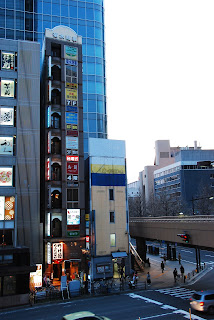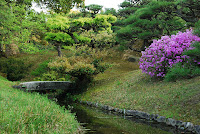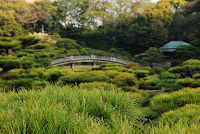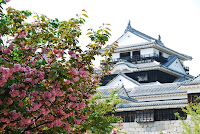...before he has seen all of Japan?
The titles of this post and the previous one stem from the Japanese love of rules, even in their free time. As a result, all tourist attractions feature plentiful and often disruptive signage pointing the intrepid explorer towards the right "route", "path" or "track". Not that this is not usually the only way to go anyway, but the obsession with being told where to go took me aback a bit. Alas, I heartily disagree with the notion that the best thing to do when seeing something new and exciting is to exactly follow a pre-prepared fast track past all the attractions. Fortunately, the northern end of Honshu, Japan's main island, provided some welcome respite from this "beeline tourism".
The region of Tohoku is a relative backwater dominated by rural communities and small towns. Nevertheless, it is crisscrossed by Shinkansen lines as well as regional trains which made getting around easy. I based myself in Sendai, a very pleasant but unremarkable city near Fukushima which, like its infamous neighbour, was hit quite hard by the 2011 tsunami. Fortunately, no lasting damage occurred and the city is more or less back to normal again. From here, I undertook day trips, offering a small prayer of thanks to the Rail Pass every time: without it, I would have had to pay a small fortune to get around all the places I visited.
My first excursion was to Matsushima, which is famous as one of Japan's "Three Views". Classification of attractions is generally popular here - there are also things like the "Three Famous Castles" - which then naturally have to be supplemented by the "Three Great Mountain Castles", the "Three Famous Flatland Mountain Castles", and so on. Feels a bit like a manifestation of the "everyone's a winner" culture...but the Three Views are the original, so I figured this would be a worthwhile day trip.
The area does boast some impressive natural splendour, diminished only a little by the haze lingering in the sky on the day of my visit. What diminished it a lot more were the innumerable cruise ships and the inevitable concrete jungle lining the waterfront. Also, Japanese town planners seem to have a knack for placing giant electricity pylons right across of the most scenic views. The area is also known for its oysters and crabs - but why they had to litter the entire bay which is home to this famous natural treasure with industrial ports and fishery buoys is beyond me.
Anyway, I boarded a tourist ferry with fairly low hopes, but ended up having a good time. The air cleared a little as we sailed further out, and we were entertained by huge flocks of seagulls who received a rapturous welcome by the predominantly Japanese tourists on the boat.
They must have a pretty easy life out here, with the food from snack stalls on the waterfront probably feeding seagulls as much as people...and their fearlessness meant that they made for good models.
With hundreds of islands dotting the entirety of Matsushima Bay (matsu translates as pine, and shima as island...an almost drab name compared to the normally flowery Japanese nomenclature!), a few have eroded into interesting shapes over the years. Some of the more precarious ones collapsed during the 2011 earthquake, but given that the islands protected the shore from the brunt of the tsunami, that's not something to lament overmuch.
Surprisingly, even the area immediately surrounding the tourist ferry dock is pretty run down - a stark contrast to glitzy Tokyo and immaculate Kyoto!
The next day I headed inland to Yamadera, where a small shrine clings to a cliff in the foothills of the Japan Alps. It is still pretty chilly up here in April, so the sun was very much appreciated. I had expected a bit of a hike, but in fact climbing to the top of the shrine only took about 15 minutes. There was an inviting-looking ridge leading further up and to what looked like a spectacular outlook, but the way was closed and guarded by attentive-looking monks in one of the ubiquitous gift shops. Still, the scenery was very pretty all around and being in the hills, if not the mountains, made for a nice change.
My last stop up north was in the Tono Valley, an almost completely agricultural region - and one of Japan's poorest. It is marketed as a place to escape civilisation, and also as one where the stories and folk tales of old still live. In particular, they seem to make a big deal out of Kappas - small mischievous imps who live in rivers and ponds. The tourist guides and prospectuses go on about little else, but sadly I failed to spot one. Still, my bike ride through the valley proved thoroughly enjoyable despite the fact that even at maximum seatpost extension my knees were woefully bent.
As I climbed a half-overgrown staircase up into the forest in search of a shrine indicated by the roadside, I made a bit of a startling discovery. Out of the corner of my eye I spotted an animal with dark grey and white fur which stood out against the brown-and-green forest backdrop. My first reaction was that it was a wolf - when I actually turned to look at it this proved ridiculous, but the fur may lend me some credence:
Upon returning to Sendai, my research revealed that this was in fact a Japanese Serow, a tall goat-like affair. Since they normally rest and hide during the day I have no idea what it was doing up and about - but it seemed similarly startled by my appearance. Clearly this particular shrine isn't much frequented...
Having exhausted the surroundings of Sendai that are accessible without a car, I set my sights further South, on Shikoku. This is the smallest of Japan's four main islands and has a reputation of being less touristy than the rest of Japan. Indeed, the Shinkansen network does not cover Shikoku and English signage and general communication is available much less here. Nevertheless, this ended up being one of my favourite parts of Japan!
My first stop was in Takamatsu, a nondescript place just across the Inland Sea from Honshu. The two islands are connected here by a seemingly endless bridge, though this makes for a nice change from more conventional, tunnel-based means of crossing a sea. However, Takamatsu does have a stunning garden; I wish I'd taken my tripod along when I visited it!
It was also in Takamatsu that I had the pleasure of staying in one of Japan's famous capsule hotels. They sound a lot worse than they are - unlike the coffin-like images their name evokes in most people's imaginations, the "capsules" are actually pretty spacious. They are also cheap, and come with various pleasant extras like an in-house bath house, massage chairs and the possibility of lounging around in a dressing gown all evening. Most are male-only, although this is more a concession to the fact that they cater mostly to businessmen (who continue to be almost exclusively male in Japan) and to the fact that this makes bath-house logistics simpler.
The real highlight of Shikoku, though, was Matsuyama, where I headed next. I suspect staying in a very pleasant guesthouse run by an American and his Japanese wife - both of whom spoke great English - helped an immeasurable amount here. Being given simple and clear advice and directions and having people to talk to cheered me up no end, and allowed me to get out there and see some really quite stunning parts of the country. But first, the standard castle visit...
Now one thing Shikoku is known for is a pilgrimage which takes the pilgrim to 88 temples dotted all around the island. Completing it on foot takes anywhere between six and eight weeks, so this is mostly done by retirees as Japanese workers are lucky if they have even two weeks of holiday a year. Pilgrims wear white vests and the conical straw hats one might expect in a 1950s comic involving Asians. Following the advice of Matt the guesthouse co-owner, I headed out of town to walk the path from Temple #44 to #45 and back again. This proved fantastic advice - after a brief stretch of walking on a road (and through a tunnel...certainly a novel experience!) the pilgrim route meandered off into virgin forest.
What followed was an absolutely beautiful forest walk, punctuated at one point by a clearing where a handful of farms clustered in the sunshine. They were far from any roads, this was real oldschool stuff!
Temple #45, then, was an unusual affair - buildings were few and far between, and instead small figurines and statues were dotted along the path, which here descended a steep hillside in switchbacks, or tucked away in alcoves
.
Right; I think that's enough for now! One more post on Japan to go, before we finally turn to Korea. It's hard to believe that I've now been on the road for well over six months - and that it's just two-and-a-bit weeks till I'm back home again!
The titles of this post and the previous one stem from the Japanese love of rules, even in their free time. As a result, all tourist attractions feature plentiful and often disruptive signage pointing the intrepid explorer towards the right "route", "path" or "track". Not that this is not usually the only way to go anyway, but the obsession with being told where to go took me aback a bit. Alas, I heartily disagree with the notion that the best thing to do when seeing something new and exciting is to exactly follow a pre-prepared fast track past all the attractions. Fortunately, the northern end of Honshu, Japan's main island, provided some welcome respite from this "beeline tourism".
The region of Tohoku is a relative backwater dominated by rural communities and small towns. Nevertheless, it is crisscrossed by Shinkansen lines as well as regional trains which made getting around easy. I based myself in Sendai, a very pleasant but unremarkable city near Fukushima which, like its infamous neighbour, was hit quite hard by the 2011 tsunami. Fortunately, no lasting damage occurred and the city is more or less back to normal again. From here, I undertook day trips, offering a small prayer of thanks to the Rail Pass every time: without it, I would have had to pay a small fortune to get around all the places I visited.
 |
| I particularly enjoyed this impracticably narrow house - and it doesn't even have a wider section round the back! |
The area does boast some impressive natural splendour, diminished only a little by the haze lingering in the sky on the day of my visit. What diminished it a lot more were the innumerable cruise ships and the inevitable concrete jungle lining the waterfront. Also, Japanese town planners seem to have a knack for placing giant electricity pylons right across of the most scenic views. The area is also known for its oysters and crabs - but why they had to litter the entire bay which is home to this famous natural treasure with industrial ports and fishery buoys is beyond me.
Anyway, I boarded a tourist ferry with fairly low hopes, but ended up having a good time. The air cleared a little as we sailed further out, and we were entertained by huge flocks of seagulls who received a rapturous welcome by the predominantly Japanese tourists on the boat.
They must have a pretty easy life out here, with the food from snack stalls on the waterfront probably feeding seagulls as much as people...and their fearlessness meant that they made for good models.
With hundreds of islands dotting the entirety of Matsushima Bay (matsu translates as pine, and shima as island...an almost drab name compared to the normally flowery Japanese nomenclature!), a few have eroded into interesting shapes over the years. Some of the more precarious ones collapsed during the 2011 earthquake, but given that the islands protected the shore from the brunt of the tsunami, that's not something to lament overmuch.
Surprisingly, even the area immediately surrounding the tourist ferry dock is pretty run down - a stark contrast to glitzy Tokyo and immaculate Kyoto!
 |
| Strong eyes. |
 |
| I don't even know whether this is a customisation or whether some designer thought this would be a great idea... |
The next day I headed inland to Yamadera, where a small shrine clings to a cliff in the foothills of the Japan Alps. It is still pretty chilly up here in April, so the sun was very much appreciated. I had expected a bit of a hike, but in fact climbing to the top of the shrine only took about 15 minutes. There was an inviting-looking ridge leading further up and to what looked like a spectacular outlook, but the way was closed and guarded by attentive-looking monks in one of the ubiquitous gift shops. Still, the scenery was very pretty all around and being in the hills, if not the mountains, made for a nice change.
 |
| Yeah mountains! A return to Nepal seems ever likelier... |
 |
| Strong colours under changeable skies. |
My last stop up north was in the Tono Valley, an almost completely agricultural region - and one of Japan's poorest. It is marketed as a place to escape civilisation, and also as one where the stories and folk tales of old still live. In particular, they seem to make a big deal out of Kappas - small mischievous imps who live in rivers and ponds. The tourist guides and prospectuses go on about little else, but sadly I failed to spot one. Still, my bike ride through the valley proved thoroughly enjoyable despite the fact that even at maximum seatpost extension my knees were woefully bent.
 |
| A mini-bulldozer - possibly the best vehicle ever. |
 |
| Decided shortage of kappa... |
 |
| White balance fail - but a very pretty forest! |
 |
| Call me a scaremonger, but that doesn't strike me as the best place for a little shrine... |
Upon returning to Sendai, my research revealed that this was in fact a Japanese Serow, a tall goat-like affair. Since they normally rest and hide during the day I have no idea what it was doing up and about - but it seemed similarly startled by my appearance. Clearly this particular shrine isn't much frequented...
Having exhausted the surroundings of Sendai that are accessible without a car, I set my sights further South, on Shikoku. This is the smallest of Japan's four main islands and has a reputation of being less touristy than the rest of Japan. Indeed, the Shinkansen network does not cover Shikoku and English signage and general communication is available much less here. Nevertheless, this ended up being one of my favourite parts of Japan!
My first stop was in Takamatsu, a nondescript place just across the Inland Sea from Honshu. The two islands are connected here by a seemingly endless bridge, though this makes for a nice change from more conventional, tunnel-based means of crossing a sea. However, Takamatsu does have a stunning garden; I wish I'd taken my tripod along when I visited it!
It was also in Takamatsu that I had the pleasure of staying in one of Japan's famous capsule hotels. They sound a lot worse than they are - unlike the coffin-like images their name evokes in most people's imaginations, the "capsules" are actually pretty spacious. They are also cheap, and come with various pleasant extras like an in-house bath house, massage chairs and the possibility of lounging around in a dressing gown all evening. Most are male-only, although this is more a concession to the fact that they cater mostly to businessmen (who continue to be almost exclusively male in Japan) and to the fact that this makes bath-house logistics simpler.
 |
| Rows upon rows... |
 |
| ...and the cosy inside. Plenty of headroom when sat up and comfortably wide, with a screen for the "entrance" at my feet - really can't complain, especially for a tenner a night in urban Japan! |
 |
| Matsuyama tram fun! |
 |
| Track markings for the pilgrimage. |
What followed was an absolutely beautiful forest walk, punctuated at one point by a clearing where a handful of farms clustered in the sunshine. They were far from any roads, this was real oldschool stuff!
 |
| Not sure if shrine, impromptu dining table or random stuff... |
.
 |
| This guy seemed particularly angry about something... |
Right; I think that's enough for now! One more post on Japan to go, before we finally turn to Korea. It's hard to believe that I've now been on the road for well over six months - and that it's just two-and-a-bit weeks till I'm back home again!





































No comments:
Post a Comment